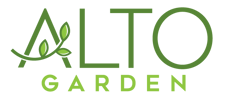
What is a Hydroponic Tower Garden?
These vertical tower gardens use a growing method called “hydroponics” to cultivate plants and produce. With traditional growing methods, seeds are planted in soil. The grower then waters the soil to keep the soil moist so the roots can absorb water.
With hydroponics, soil is not used. Hydroponic towers do not use any soil. Instead, the base of the plant and its roots are supported by net pots. The bottom of these net pots are suspended in air with the roots exposed inside the tower.
The tower garden is shaped like a tall cylinder with a reservoir tank at the bottom. A water pump is used to pump water to the top of the tower. Roots of the plants are watered as water drips back down and into the reservoir tank below. Water is pumped back up and the process repeats. You probably realize now, the water efficiency a hydroponic garden provides. This is one of the key advantages of hydroponic towers.
A common question is – how long do you water the garden? Assuming your plants were germinated in rockwool - a general rule of thumb is to let the pump run 15 minutes every hour. So, 15 minutes on and 45 minutes off, for 14 – 18 hours a day (less hours when it's cooler, more hours when it's warmer). But if you germinated in sponge cubes - you'll need more frequent watering because sponges don't retain water as well. More like 15 minutes on and 15 minutes off, for 24 hours a day. More on this in the germination section of our website. In warmer months, you should increase your watering frequency.
Note this is a general guideline and the watering schedule should be adjusted as needed. For example, because of their bigger root systems mature plants can retain water better than younger plants. This means mature plants can do well over longer periods without water.
Hydroponics >>> Aeroponics
This interval-based watering method brings us to a related topic called, “aeroponics.” Aeroponics falls under the umbrella of hydroponics. It is a type of hydroponics... an analogy would be to say, a laptop computer is a type of computer. There are laptop computers, desktop computers and tablet computers but they are all computers. Likewise, aeroponics is a type of hydroponics.
In most traditional hydroponic systems, plant roots remain submerged in water 24 hours a day. But with aeroponics, roots are also exposed to more air, than water! This is important because roots require oxygen. Roots can and do absorb oxygen while underneath water, but oxygen absorption is more efficient when roots are exposed directly to air. This leads to another advantage of aeroponic systems – faster plant growth.
So technically speaking, hydroponic towers are actually aeroponic towers. Plant roots are exposed to air most of the time, with a short watering interval every hour or so. We want you to be knowledgeable of these specifics while learning about hydroponics and aeroponics. But to keep things simple, let's stick with the term “hydroponics” for now.
Let's Get Back to Watering
What’s nice about hydroponic towers is the water pump can be used with an automated timer. This lets you water your vegetables and herbs at a watering schedule that’s right for whatever stage of growth your plants are in. Run it for 12 hours, or run it for 16 hours. Whatever is suitable for right now. The automation makes it easy. There is no hand-watering involved at all with your garden. Everything is automatically run, according to a schedule you determine.
Since water is recycled up and down the tower, water efficiency is a key benefit you’ll enjoy with a hydroponic tower. With traditional farming, less than 5% of water used is actually absorbed by plant roots. This makes soil watering highly inefficient. It would be great if this water could be recycled, but the reality is that it’s lost in the ground and we can’t get it back.
But hydroponic towers DO recycle water. This is why these efficient systems use 95% less water than traditional farming methods!
Watering in a tower garden is specifically targeted to flow over the roots. As water drips off the roots, it makes its way down to the reservoir tank to be pumped back up the tower and down again. Because of this efficiency, a hydroponic garden reduces water waste and costs. These growing systems are especially popular in dryer and more arid parts of the world, such as in desert cities and the middle east. Water is more scarce in these regions so it makes sense why these systems are in such high demand there.
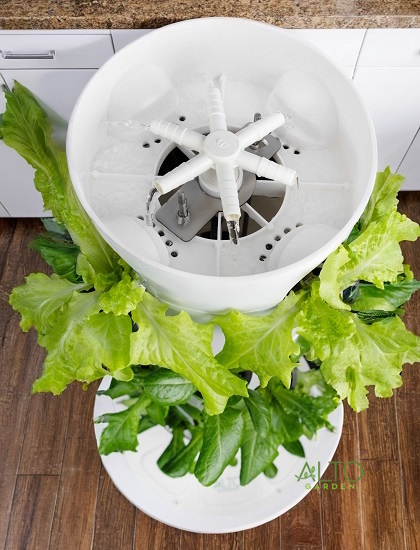
Growing Vertically
We’ve all seen pictures of farms and their never-ending fields, growing crops as far as the eye can see. One head of lettuce takes up a whole square foot on a farm. Growing produce horizontally in this manner consumes acres and acres of land. It requires incredibly vast amounts of land.

In contrast – tower gardens grow vertically. In less than THREE square feet, you can grow 24 heads of lettuce (or more). That is 8x more yield per square foot! So not only do tower gardens use less water, they use a lot less land as well.
This concept of vertical gardening is especially appealing to people who don’t have front or back yards. This is particularly true in highly populated urban areas where most people live in apartments, condos and townhomes. Some people may have a limited garden on their balcony area, but again – they are confined by space. You need to leave room for a grill on your balcony too. Maybe a small table and a couple of chairs. Balcony space is precious so you’re going to have to decide on some trade-offs.
But just because you live in a condo doesn’t mean you can’t have a full garden. People who live in apartments and condos want to grow their own food too. You can place a hydroponic tower on your balcony and grow a bounty full of vegetables and herbs. It would take up the same amount of space as a chair. Or, if your tower comes equipped with grow lights, you can bring it inside and grow indoors.


Hydroponic Gardens & Grow Lights
We all learned as young children that plants require two things to thrive – water and sunlight. Sunlight is key to photosynthesis, without which plants cannot survive. But it can be hard to find to find enough sunlight if you’re growing indoors. This is where grow lights come into play. Prior to the early 2000’s, grow lights were actually quite expensive to run and maintain. Some indoor enthusiasts may remember the days of high pressure sodium light bulbs, which cost more than $50 a pop! For one bulb! God forbid you should break one. Not only were they expensive to buy and replace, they needed a lot of energy to run.
Around 2008 – LED light technology started to flourish and become more widely available for hydroponic gardens. LED lights were way cheaper to produce, lasted for tens of thousands of hours (some even up to 100,000 hours), and required a fraction of the energy of traditional bulbs. Fast forward to the 2020s and LEDs dominate the lighting market. They are in our homes, offices, restaurants, cars… they're everywhere. They are so prevalent now it can be hard to find incandescent bulbs these days.
Most hydroponic towers come with the option of buying with or without LED grow lights. If you have an outdoor space in mind that gets plenty of sun, that would be a good spot for your hydroponic tower garden. Or, if you have an area inside with good sunlight (ideally next to a south-facing window if you live in the northern hemisphere), that could work too. But if you’re planning on growing indoors, you’ll want a tower with lights to ensure your plants are getting the lighting they need.
It’s easiest if you use a timer to automate your lighting schedule. For example, you can set your timer to turn the lights on at 7am and off at 9pm. For indoor lighting set your timer so it runs 12 – 16 hours a day, followed by 8 – 12 hours of darkness. Keep the same daily schedule as your plants will become used to the lights turning on and off at the same time every day. Yes – your plants are alive and they will notice! A regular period of darkness is actually quite important. Note that some plants require more lighting than others. Fruits, like tomatoes and strawberries, will need more light than lettuce.
Some things to keep in mind:
Light coverage – do the lights provide good coverage for all areas of the tower where plants will grow? Make sure to have good coverage from top-to-bottom and side-to-side.
Light adjustability – can you turn / rotate the lights 360 degrees around the tower? This lets you fine-tune your lighting. Can you adjust the lights closer / farther away from the tower? Like bringing the lights closer towards seedlings, but extending the lights further away as they grow.
We should also talk about the lighting spectrum. When you’re outside, sunlight appears to your eyes as white light. In reality though – the sun is actually emitting all the visible colors of the spectrum at the same time. Because the sun emits all of these colors fairly evenly, we see the light as white. But if you emit sunlight through a prism you'll see all the colors of the rainbow! And thus - natural sunlight is a broad spectrum light. All plants and vegetation on Earth grow under this broad spectrum lighting, and you want similar lighting when bringing your gardening indoors. Ideally, your grow lights cover the entire spectrum like the chart below:
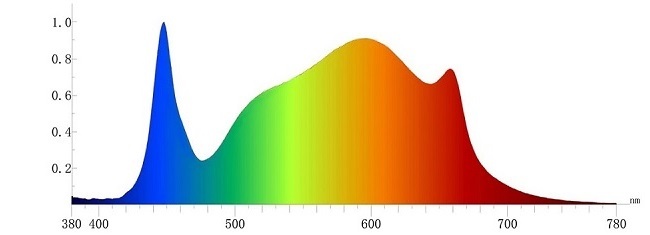
A common question is, are white LED lights broad spectrum? Yes – they are! That being said, certain parts of the lighting spectrum are better at certain stages of plant growth. For example – blue light is better during earlier parts of plant growth, while red light is better at the flowering stage. Professional growers fine tune their lights by adding more blue light or red light depending on the growth stage of the plant.
White LED lights are a good all-purpose light because they emit the full range of wavelengths. But depending on the growth stage, white LED lights may not be the most efficient at that given moment. While white LEDs are suitable for different growth stages overall, they can also be supplemented with other diode colors - usually red. LED lights have made it easier for amateur growers to grow at home.
Components of the Tower
You may look at a hydroponic tower garden, and think it’s just a plastic tower. But you should know that certain plastics are considered “food safe” while others are not. Note the recycling numbers at the top of the chart, ranging from 1 – 7. FDA approved, food-safe plastics are:
#1 - Polyethylene Terephthalate (PETE)
#2 - High-Density Polyethylene (HDPE)
#4 - Low-Density Polyethylene (LDPE)
#5 - Polypropylene (PP)
When looking for a hydroponic tower garden, make sure to check the specific type of plastic used and make sure it’s made from one of these food-safe plastics.
About BPA: Bisphenol A (BPA) is a chemical used to make some types of plastics. Research has shown that BPA can leach into food, from containers made with BPA. BPA may negatively affect bodily functions such as cell repair, cell growth and fetal development. Inflammatory effects of BPA have also been linked to heart disease and type 2 diabetes.
The four plastics listed above are all BPA-free.
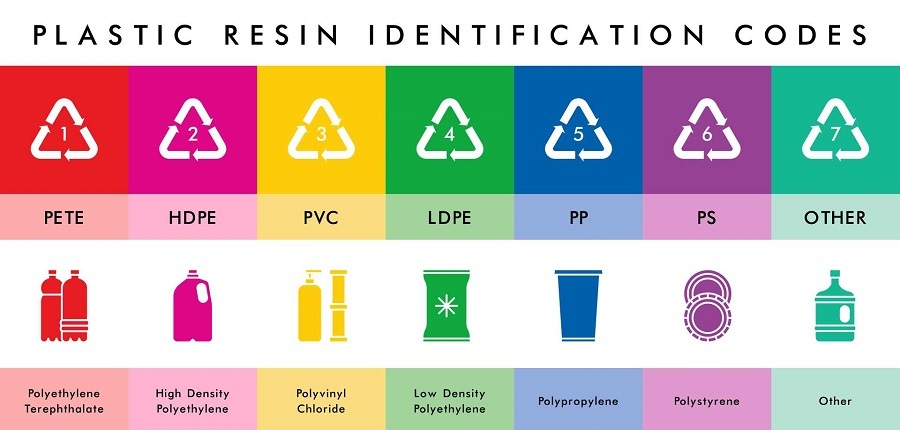
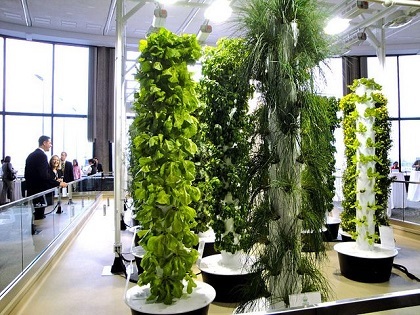
The Future of Farming
Given all the benefits a hydroponic garden provides, you may wonder if it's the future of farming. Well, it depends how you look at it. For micro farms at home, it’s a distinct possibility. Some may argue it’s already arrived.
Growing hydroponically has its advantages - self watering, self lighting systems which produce faster yields without soil. Food that’s grown in small batches free of pesticides, without GMOs, that's ready to eat. And you don’t need a backyard. You can live in an apartment or condo, set up your tower indoors (or outside on your balcony) and start harvesting in a matter of weeks.
But large scale hydroponic farming comes with a different set of challenges. While hydroponics has been around for a few decades, traditional farming with soil has been around for thousands of years.
Even with the tremendous savings in both land and water, hydroponics is difficult to scale for industrial farms. Growing one or two towers at home is easy. Set a couple of timers and it’s automated for you. But growing hundreds or even thousands of healthy garden towers is a different story altogether.
For an industrial farm there would be pretty high set up cost. A capital outlay would be needed to purchase the hydroponic towers and shelves, build the water management system, and train the farmers to use these systems. All the components and equipment would need to be watched more closely than an outdoor farm. New electrical would be needed to manage the water supply. And this is just for a new farm. For existing farms transitioning to hydroponics, they would have millions of dollars invested in traditional farming equipment which would no longer be used.
As we learn more about hydroponics and it becomes more developed, it will be interesting to see how it takes shape. In the arid and desert regions, hydroponics has already become widely adopted for industrial use. Water is more at a premium in these areas so the benefits outweigh the costs. Smaller scale farms in other parts for the world are starting to better understand how to utilize hydroponic methods too. And in single family homes - they are useful because of their small foot print and fast yields. Let’s stay tuned to see how it all unfolds.
FAQ
You can grow organic lettuce, vegetables, herbs, and fruits in a hydroponic tower garden.
The tower only takes up three square feet, making it perfect for small spaces.










